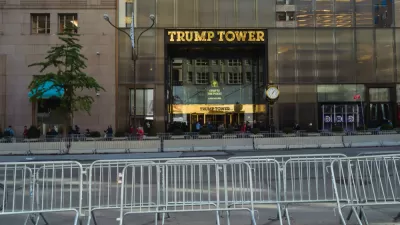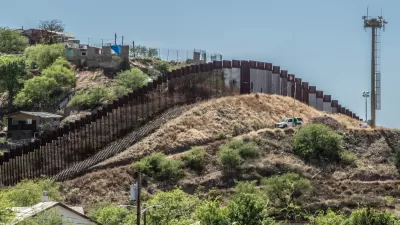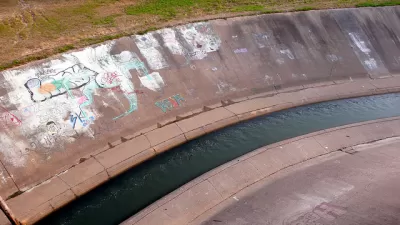President Trump's first State of the Union address followed the rhetoric of his campaign and first year in office, offering few details about promised infrastructure investments and avoiding substantive discussion about the future of cities.

Last night's State of the Union address didn't touch on many subjects of direct or obvious relevance to planning and planners, but there were a few nuggets of relevant policy to pick up on—the main one being a suddenly ballooning number attached to the Trump Administration's long-promised infrastructure plan.
But before we talk about the infrastructure plan, let's talk about a few of the less obvious angles for planners.
Immigration Reform
One of the main themes of the speech was immigration, and here president Trump proposed a four pillar plan to reform immigration. Analyzing the political viability of this proposal, and its effects on the county, is a task for other publications, but I mention it to note, in case anyone forgot, that immigration policies do affect planning outcomes. Here's a sample of reading from the Planetizen archives surveying some of the ways that the issues of immigration intersect with the practice of planning:
- Could Immigration Crackdowns Crash the Housing Market? (March 2017)
- Immigration Tied to Economic Success (February 2017)
- Both Sides of the Controversial Renewal of the EB-5 Immigration Program (December 2015)
- A New Remedy for America's Complicated Immigration History (April 2015)
- Mapping Immigration’s Effect on Boston Neighborhoods (March 2014)
- Is International Immigration the Solution for Declining Cities? (September 2014)
- The Importance of Immigrants in America (May 2011)
- How "Arrival Cities" Are Shaping the Future (September 2010)
- The Economic Stimulus of Immigration Reform (December 2009)
Dismantling the Federal Bureaucracy
Another issue of oblique relevance to planning was the section of the speech about new powers to fire federal employees:
All Americans deserve accountability and respect -- and that is what we are giving them. So tonight, I call on the Congress to empower every Cabinet Secretary with the authority to reward good workers -- and to remove Federal employees who undermine the public trust or fail the American people.
Most pundits are reading this section as a reference to the former FBI Deputy Director Andrew McCabe and Special Counsel Robert Mueller. But the mention of "Cabinet Secretaries" reminded me more of the purging underway at the Environmental Protection Agency (not a cabinet-level federal department, yes, but the arm of the federal government already implementing the removal policies Trump describes here). There's also the Department of the Interior, where Secretary Ryan Zinke has lamented the lack of loyalty to him and the president among the ranks of employees in that department. In other words, I took these words as a threat to federal bureaucrats, including planners.
This section made for an easy segue to boasts about how many regulations the Trump Administration has ended. With no environmental regulations to enforce, there will be a lot less work for planners in the federal government.
Infrastructure
Finally, the big ticket item that has been long awaited by observers on both sides of the aisle, teased by the Trump Administration repeatedly over the course of its first year in power, and even partially leaked earlier this year. Still, very few details are known about how the Trump Administration plans to deliver on its $1 trillion infrastructure promise.
Wait…scratch that. President Trump took the state at the State of the Union and, as he is wont to do, raised the stakes by half a trillion dollars. Here's the whole section of the speech on the subject of infrastructure:
As we rebuild our industries, it is also time to rebuild our crumbling infrastructure.
America is a nation of builders. We built the Empire State Building in just 1 year -- is it not a disgrace that it can now take 10 years just to get a permit approved for a simple road?
I am asking both parties to come together to give us the safe, fast, reliable, and modern infrastructure our economy needs and our people deserve.
Tonight, I am calling on the Congress to produce a bill that generates at least $1.5 trillion for the new infrastructure investment we need.
Every Federal dollar should be leveraged by partnering with State and local governments and, where appropriate, tapping into private sector investment -- to permanently fix the infrastructure deficit.
Any bill must also streamline the permitting and approval process -- getting it down to no more than two years, and perhaps even one.
Together, we can reclaim our building heritage. We will build gleaming new roads, bridges, highways, railways, and waterways across our land. And we will do it with American heart, American hands, and American grit.
Following up the big dollar figure by talking about streamlining permitting and approval processes was a vague move that falls flat to anyone who has ever heard a million politicians make the same promise. Saying the process should take "no more than two years, and perhaps even one," President Trump did not mention any specifics of how that change could be realized, for what kinds of projects, and with what consideration given to local and state regulations.
The State of the Union's infrastructure talk fired up the pundits, inspiring numerous hot takes on how the developer president plans to move forward with his long-promised ambitions to rebuild the nation's infrastructure. Among the recommended reading from the Internet in the wake of the State of the Union:
- An article by Laura Bliss for CityLab disabuses the notion that the Trump Administration's infrastructure plan can be construed as bipartisan.
- Rep. Marcia L. Fudge (D-Ohio) put out a statement following the speech that describes Trump's agenda on immigration and infrastructure as "shallow." Moreover, according to Rep. Fudge, they "do not negate the President’s irrational behavior, divisive rhetoric, and destructive policies that have negatively impacted low and middle income families and communities of color."
- Writing for the U.S. News and World Report, Jeff Davis says it’s a "challenge" to figure out what President Trump means when he talks about infrastructure. With regard to the $1.5 trillion in funding the president promises, Davis writes: "Trump's fiscal 2019 budget proposal, due out in mid-February, will include a more detailed proposal to spend $200 billion in federal appropriations over the next 10 years that will, presumably, bring forth the other $1.3 trillion in state, local and non-federal infrastructure investment to get to that aspirational $1.5 trillion number."
- Elana Schor and Seung Min Kim also noticed the discrepancy in funding promises, and in an article for Politico they quote congressional representatives from both sides of the aisle expressing disappointment about the ongoing lack of specifics with regard to funding for the infrastructure plan.
An untouched transcript of the president's State of the Union address is available on the CNN website. For an annotated and fact-checked transcript, reference the work of the political team at NPR.

Study: Maui’s Plan to Convert Vacation Rentals to Long-Term Housing Could Cause Nearly $1 Billion Economic Loss
The plan would reduce visitor accommodation by 25,% resulting in 1,900 jobs lost.

Alabama: Trump Terminates Settlements for Black Communities Harmed By Raw Sewage
Trump deemed the landmark civil rights agreement “illegal DEI and environmental justice policy.”

North Texas Transit Leaders Tout Benefits of TOD for Growing Region
At a summit focused on transit-oriented development, policymakers discussed how North Texas’ expanded light rail system can serve as a tool for economic growth.

San Diego County Sees a Rise in Urban Coyotes
San Diego County experiences a rise in urban coyotes, as sightings become prevalent throughout its urban neighbourhoods and surrounding areas.

Los Angeles County Invests in Wildfire Recovery for Parks, Trails, and Open Space
The $4.25 million RESTORE Program supports the recovery of parks, trails, and open spaces damaged by the January 2025 wildfires through targeted grants that promote community healing, wildfire resilience, and equitable access to nature.

Nevada Bills Aim to Establish Home Insurance Assurance Amidst Wildfire Risk
Republican sponsor hopes the FAIR plan would be “a true market of last resort.”
Urban Design for Planners 1: Software Tools
This six-course series explores essential urban design concepts using open source software and equips planners with the tools they need to participate fully in the urban design process.
Planning for Universal Design
Learn the tools for implementing Universal Design in planning regulations.
Smith Gee Studio
Alamo Area Metropolitan Planning Organization
City of Santa Clarita
Institute for Housing and Urban Development Studies (IHS)
City of Grandview
Harvard GSD Executive Education
Toledo-Lucas County Plan Commissions
Salt Lake City
NYU Wagner Graduate School of Public Service






























